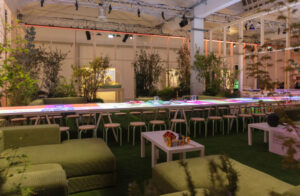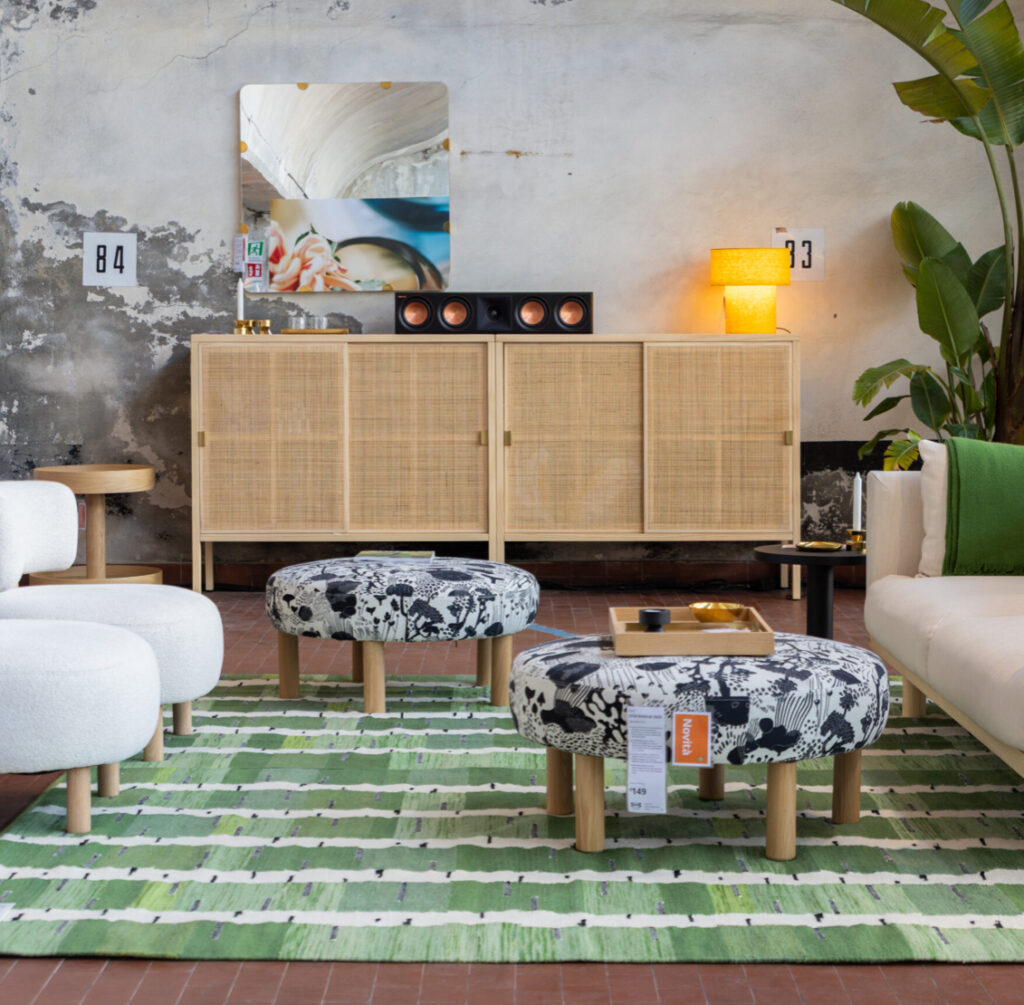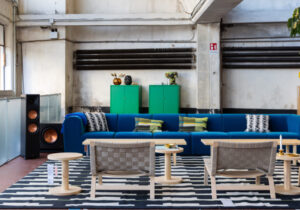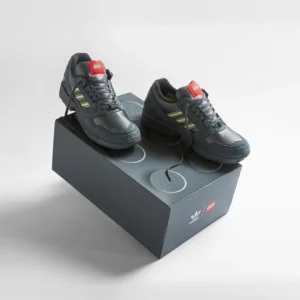
There is a peculiar calm that accompanies an IKEA showroom. Despite the inevitable weekend crowds and yellow bags filled to the brim with things you never planned to buy, there’s a strangely utopian quality to it all — a dreamlike proposition where living better doesn’t have to cost more, and where even the smallest flat can be transformed into a cathedral of function and form. This is not an accident. It is the result of a decades-long mission rooted in what IKEA calls demokratisk design: the belief that well-made, aesthetically pleasing, and affordable furniture is a right, not a luxury. And in 2025, that mission is expanding — globally, creatively, and most crucially, relationally.
Fresh off a celebrated showing at Salone del Mobile in Milan, the Swedish furniture titan is continuing to reposition itself not just as a manufacturer of home goods, but as a cultural conduit — one that doesn’t dictate taste from the top down, but rather sits at eye level with the people it serves. IKEA’s brand of inclusivity is no longer a matter of product pricing or store count. It’s a structural reimagining of access, participation, and aesthetic agency.
Just days ahead of the opening of IKEA’s new flagship on Oxford Street — a move signaling the company’s commitment to central urban retailing — the question isn’t whether IKEA can still resonate in a saturated, design-savvy world. It’s how it intends to lead it.
A New Kind of Centerpiece: Milan to London and Beyond
At Salone del Mobile, the world’s most influential furniture fair, expectations run high. It’s the place where the elite of the design world come to flex — where extravagance often outweighs utility and craftsmanship sometimes eclipses relevance. In such a context, IKEA’s presence could have felt out of place. Instead, it felt necessary.
Their 2025 exhibition, “1st,” was conceptualized not as a product launch, but as a provocation. Using everyday domestic scenarios as their medium — a student’s cramped desk space, a family’s rotating dinner table, a teenager’s unmade bed — IKEA offered viewers a meditation on intimacy, flux, and the ordinary rituals that define us. The installation blurred the line between sculpture and utility, functioning less as an ad and more as a study of domestic life in motion.
What emerged was not just a celebration of form, but a reaffirmation of purpose: furniture that answers to life as it is, not as it’s idealized. IKEA’s Salone presence suggested a philosophical pivot — or perhaps a return — to the foundational ethos of Ingvar Kamprad’s original vision. In a world obsessed with exclusivity and spectacle, IKEA doubled down on the quiet radicalism of the everyday.
The New Oxford Circus Store: Urban Access Reimagined
Oxford Street, with its honking buses, thrumming foot traffic, and gleaming window displays, isn’t where one typically envisions assembling a MALM dresser. But that’s precisely the point. The new IKEA location — set inside the repurposed Topshop building — is less a retail expansion than a symbolic one.
Traditionally, IKEA stores were located on city outskirts, accessible by car, inviting customers into the almost theme-park-like experience of its blue-and-yellow behemoths. Inverting that model, the Oxford Street store marks a new strategy: bring the design to the people. It’s not about warehouse browsing anymore. It’s about accessibility, convenience, and cultural fluency in the thick of metropolitan life.
This flagship isn’t simply a store — it’s a hub. With curated spaces, expanded interior design services, and AI-assisted planning tools, IKEA is streamlining how people imagine their spaces. The urban environment has unique demands: square footage is scarce, ceilings are low, and lives are transient. IKEA’s newest retail concept reflects these dynamics with hyper-localized inventory and on-site pickup, plus a digital showroom strategy that integrates seamlessly with its app and virtual planners.
The subtext is clear: democratic design must now include democratic logistics. It’s not enough to design for everyone; those designs must also reach everyone.
The Table as Metaphor: Design that Welcomes
The table is, arguably, the most symbolic object in IKEA’s catalogue. Whether it’s the collapsible NORBERG, the blocky LINNMON, or the elegantly rounded LISABO, the table represents more than just surface area. It’s where families gather, where plans are drawn, where meals and memories are made. It’s also, fittingly, IKEA’s metaphor of choice for its current campaign: “Take a Seat.”
The slogan is both invitation and ideology. It suggests participation, belonging, inclusion. At a time when many global brands are contending with accusations of cultural insularity or market elitism, IKEA is leaning into a vision of global citizenship. “Take a Seat” isn’t just about buying a product. It’s about rethinking the structures — both literal and ideological — that allow people to feel at home in the world.
Part of that means redesigning the design process itself. Through initiatives like IKEA’s Co-Create platform, the company invites customers to shape future products. From crowdsourced ideas to co-developed prototypes with students and community members, the approach flattens hierarchies between designer and consumer. The customer isn’t just king — they’re connector.
Global Reach, Local Relevance
Even as IKEA becomes increasingly global in ambition, it’s doubling down on local specificity. In India, IKEA’s product range now includes masala spice racks and water-resistant storage tailored to monsoon conditions. In South Korea, its compact, modular solutions speak to micro-living in high-rise apartments. And in Nigeria, its affordable cooling technologies are being tested as climate change intensifies regional heat waves.
This isn’t tokenism. It’s adaptive design. In the past, global brands often imposed a one-size-fits-all aesthetic under the guise of minimalism. IKEA’s evolving approach recognizes that “good design” cannot be detached from cultural and environmental context. In doing so, the company moves beyond aesthetic homogeneity toward something more complex — and more just.
Sustainability at Scale: The Flat-Pack Reimagined
No discussion of IKEA in 2025 would be complete without sustainability. Long criticized for its disposable culture and mass production model, the company has spent the past decade actively rewriting its environmental playbook.
By 2030, IKEA aims to be fully circular, meaning every product will be designed with end-of-life reuse in mind. In practice, this includes:
- Buyback & Resell programs, where customers return used items for resale or recycling
- Modular design systems that allow pieces to be upgraded rather than replaced
- New materials, such as mushroom-based packaging, ocean-bound plastics, and hemp textiles
- Low-emission supply chains bolstered by renewable energy and electric delivery fleets
In the Milan showcase, one installation titled “Beyond the Flat-Pack” featured furniture designed to assemble without tools, using biodegradable joints and recycled cardboard stiffeners. It was IKEA’s way of answering the question: what does low-impact mass production look like?
More importantly, it asked: can beauty exist without environmental debt?
The Emotional Blueprint: IKEA and the Language of Belonging
For all its talk of affordability and access, IKEA’s greatest success may be emotional. It’s not just that people like IKEA furniture. They trust it. It’s the first bed after a breakup. The shelves in a child’s nursery. The lamp you keep even after upgrading to designer ones.
In an era dominated by aesthetic over-saturation and luxury fatigue, IKEA offers a rare sincerity. Its objects aren’t declarations of status, but witnesses to life. They suggest that design, at its best, is not about taste — it’s about tenderness.
The democratization of design, then, is not merely about price. It’s about language. It’s about whether people feel welcome in the spaces where design is discussed, debated, and defined. IKEA’s growing emphasis on storytelling — from in-store narratives to product history cards — underscores a desire to humanize its offerings, reminding customers that every piece has a reason for being.
Impression
IKEA doesn’t pretend to be perfect. Its scale presents challenges. Its simplicity can feel repetitive. And its ubiquity sometimes masks the sophistication behind its ideas. But to dismiss it as merely mass-market misses the point. IKEA is not here to dominate design. It’s here to democratize it.
In 2025, that means more than just lower prices. It means visibility, agency, and inclusion. It means placing designers next to users, cities next to suburbs, and sustainability next to affordability. It means asking the customer not what they want to buy — but what kind of life they want to build.
No comments yet.








